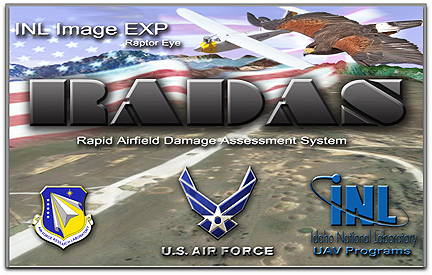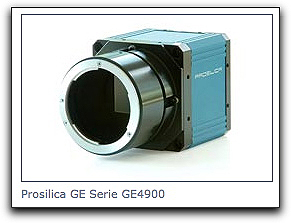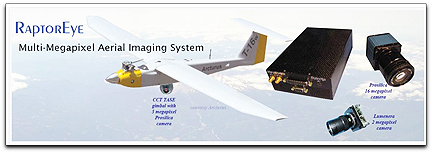The RaptorEye is used to trigger the camera, store and prepare images for transmission while recording data such as camera attitude, altitude and position in order to “tag” images with the information. The data is then sent to the UAV ground station via a state-of-the-art wireless network capable of achieving real-time wireless data retrieval of large files. The flight path and other mission requirements are programmed by ground station engineers into the mission planning software that feeds the autopilot with the data necessary to direct and control the aircraft during the mission. RADAS successfully completed a full demonstration of the system at the Tyndall Air Force Base in Florida in August 2008.
Satnews Daily
June 15th, 2009
Damage Assessment Of The Rapid Kind For UAVs
The Idaho National Laboratory (INL) is a science-based laboratory dedicated to support the U.S. Department of Energy on nuclear and energy research, science, and national defense matters.
 Following a request from the U.S. Air Force, the INL developed a UAV based system, RADAS (Rapid Airfield Damage Assessment System), for rapid airfield damage assessment. These operations are usually conducted by two, 3-man teams navigating the field in vehicles and require between 60 to 90 minutes to complete. Airfield damage assessments take place following a strategic attack on an airfield or upon initial evaluation of an enemy airfield, and therefore may expose key personnel to potentially dangerous situations. RADAS is a UAV based system capable of capturing multi-megapixel images from an altitude of 245 to 300 meters (800 to 1,000 feet) and transferring them wirelessly in near real-time to a ground base interface where each image is automatically mosaiced into a single geo-referenced map.
Following a request from the U.S. Air Force, the INL developed a UAV based system, RADAS (Rapid Airfield Damage Assessment System), for rapid airfield damage assessment. These operations are usually conducted by two, 3-man teams navigating the field in vehicles and require between 60 to 90 minutes to complete. Airfield damage assessments take place following a strategic attack on an airfield or upon initial evaluation of an enemy airfield, and therefore may expose key personnel to potentially dangerous situations. RADAS is a UAV based system capable of capturing multi-megapixel images from an altitude of 245 to 300 meters (800 to 1,000 feet) and transferring them wirelessly in near real-time to a ground base interface where each image is automatically mosaiced into a single geo-referenced map.
 RADAS incorporates the 16 Megapixel Prosilica GE4900C camera. The INL chose the GE4900C for its high resolution, excellent image quality, sensor size (35mm) and for its ease of integration, thanks to its Prosilica plug-and-play GigE interface. The camera is fitted with a prime 55mm Nikkor lens and is mounted in the payload area of the 3.3 meter (10’ 10”) wing span Arcturus T15 UAV, looking down to the ground. Image recording is automatically triggered at distance intervals based on the UAV flight plan. Once captured, the image data is transferred to the RaptorEye device onboard the UAV via cat6 cable.
RADAS incorporates the 16 Megapixel Prosilica GE4900C camera. The INL chose the GE4900C for its high resolution, excellent image quality, sensor size (35mm) and for its ease of integration, thanks to its Prosilica plug-and-play GigE interface. The camera is fitted with a prime 55mm Nikkor lens and is mounted in the payload area of the 3.3 meter (10’ 10”) wing span Arcturus T15 UAV, looking down to the ground. Image recording is automatically triggered at distance intervals based on the UAV flight plan. Once captured, the image data is transferred to the RaptorEye device onboard the UAV via cat6 cable.
 Developed by Airborne Innovations, the RaptorEye is a high performance UAV solution capable of transmitting multimegapixel images as well as metadata over a UHF broadband datalink for short missions, or low bandwidth satcom image transmissions systems for “beyond the line of sight” missions. The compact device (117x168x49mm) features a Core 2 duo processor and can provide as much as 64GB of onboard image storage and high compression performance capable of supporting real time image downlink of large format images. RaptorEye supports various interfaces including Gigabit Ethernet and works with all 2 to 16 Megapixels Prosilica cameras including the 16 Megapixel GE4900C, the 11 megapixel GE4000C, the ultra-compact 5 Megapixel GC2450C and the 2 Megapixel HD resolution GE1910C.
Developed by Airborne Innovations, the RaptorEye is a high performance UAV solution capable of transmitting multimegapixel images as well as metadata over a UHF broadband datalink for short missions, or low bandwidth satcom image transmissions systems for “beyond the line of sight” missions. The compact device (117x168x49mm) features a Core 2 duo processor and can provide as much as 64GB of onboard image storage and high compression performance capable of supporting real time image downlink of large format images. RaptorEye supports various interfaces including Gigabit Ethernet and works with all 2 to 16 Megapixels Prosilica cameras including the 16 Megapixel GE4900C, the 11 megapixel GE4000C, the ultra-compact 5 Megapixel GC2450C and the 2 Megapixel HD resolution GE1910C.
The RaptorEye is used to trigger the camera, store and prepare images for transmission while recording data such as camera attitude, altitude and position in order to “tag” images with the information. The data is then sent to the UAV ground station via a state-of-the-art wireless network capable of achieving real-time wireless data retrieval of large files. The flight path and other mission requirements are programmed by ground station engineers into the mission planning software that feeds the autopilot with the data necessary to direct and control the aircraft during the mission. RADAS successfully completed a full demonstration of the system at the Tyndall Air Force Base in Florida in August 2008.
The RaptorEye is used to trigger the camera, store and prepare images for transmission while recording data such as camera attitude, altitude and position in order to “tag” images with the information. The data is then sent to the UAV ground station via a state-of-the-art wireless network capable of achieving real-time wireless data retrieval of large files. The flight path and other mission requirements are programmed by ground station engineers into the mission planning software that feeds the autopilot with the data necessary to direct and control the aircraft during the mission. RADAS successfully completed a full demonstration of the system at the Tyndall Air Force Base in Florida in August 2008.

